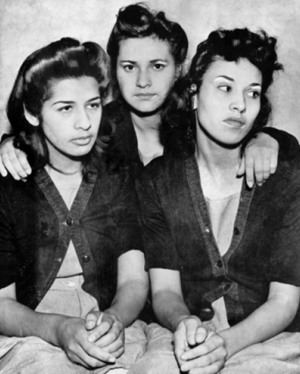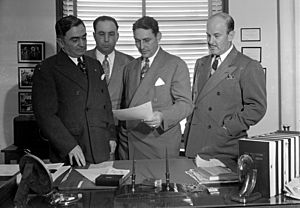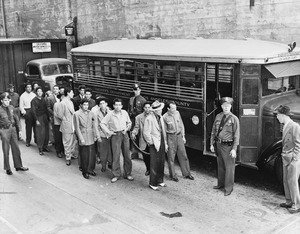Zoot Suit Riots facts for kids
Quick facts for kids Zoot Suit Riots |
|
|---|---|
| Location | Los Angeles, California, United States |
| Date | June 3–8, 1943 |
| Target | Mexican-Americans youths and other Zoot suit wearers |
|
Non-fatal injuries
|
150+ |
| Victims | 500+ arrested |
| Assailants | American servicemen, police officers, and white civilians |
| Motive | Racism, removal of zoot suits and "hoodlums" |
The Zoot Suit Riots were a series of fights that happened in Los Angeles, California, from June 3 to June 8, 1943. These events involved American soldiers, sailors, and Marines, along with young Latino and Mexican American people living in the city.
During these riots, American servicemen and white residents attacked teenagers and young people who wore zoot suits. They believed these outfits, which used a lot of fabric, were unpatriotic during World War II. At that time, fabric and certain foods were rationed to help with the war effort. Most of the violence was aimed at Mexican American youth. However, African American and Filipino American young people wearing zoot suits were also attacked.
These riots seemed to cause similar attacks against Latinos in other cities that year. These cities included Chicago, San Diego, Oakland, Evansville, Philadelphia, and New York City. The way zoot suit wearers stood up for themselves later inspired Chicano activists during the Chicano Movement.
Contents
Why the Riots Happened: The Background
Mexican Americans in Los Angeles
California was once part of Mexico before it became part of the United States. Because of this history, California has always had a large Latino population. In the early 1900s, many Mexicans moved to U.S. border states like Texas, Arizona, and California to find work. They often worked on large farms or in other jobs.
During the Great Depression in the 1930s, the United States sent many people of Mexican descent back to Mexico. This included some U.S. citizens. This was done to reduce the demand on limited economic resources. By the late 1930s, about three million Mexican Americans lived in the United States. Los Angeles had the largest number of people of Mexican heritage outside of Mexico.
Many minorities in Los Angeles faced job discrimination. This meant they had to work for very low wages. Local newspapers often wrote about Mexican people in a way that caused anger and suggested there was a problem with young people committing crimes. These things created a lot of tension between Mexican immigrants, people of Mexican descent, and white Americans.
At this time, Los Angeles was growing quickly. This growth sometimes disrupted neighborhoods and family life. For example, a large Naval training school was built in Chavez Ravine. This area was mostly home to working-class Mexican-American families. Before the riots, some young Mexican-American men from this area began to challenge the idea of white privilege. They did this through actions that led to encounters between zoot suit wearers and sailors.
Lalo Guerrero became known as the "father of Chicano music." Young people began to create their own music, language, and style of dress. Young men wore zoot suits. These were flashy suits with long jackets, baggy pants that narrowed at the ankles, and sometimes a pork pie hat, a long watch chain, and thick-soled shoes. They called themselves "pachucos". In the early 1940s, police arrested many Mexican-American youths. Negative stories in the Los Angeles Times made people think these pachuco groups were criminals and a danger to the community.
The police and newspapers often called all Mexican youths "pachuco hoodlums and baby gangsters."
World War II and Clothing Rules
When the United States entered World War II in December 1941, after the Attack on Pearl Harbor, the country faced new rules. These included rationing and the possibility of being drafted into the military. In March 1942, the War Production Board (WPB) made rules about how men's suits and all clothing with wool could be made. To save fabric, the WPB limited how much material could be used. This meant that wide zoot suits and full women's skirts could no longer be made legally. Most clothing companies stopped making or advertising suits that didn't follow these rules.
However, people still wanted zoot suits. So, some illegal tailors in Los Angeles and New York City continued to make them. Young people also kept wearing the zoot suits they already owned.
Meanwhile, many soldiers, sailors, and Marines came to Los Angeles. They were often on leave before being sent to fight in the Pacific War. Servicemen and zoot suit wearers were easy to spot by their clothing. Some servicemen and other people felt that wearing zoot suits showed that young people didn't care about the rationing rules. Officials began to link zoot suits with crime and disrespect for wartime rules. In 1943, many servicemen were upset to see young Latinos wearing zoot suits, especially since most servicemen came from areas that didn't know much about Mexican-American culture. Even though many Mexican-Americans served in the military, this didn't stop the tensions.
What Were Zoot Suits?

The Zoot suit fashion started in the urban Black community in the 1940s. This style of clothing helped create a sense of pride. Soon, it became popular among young Mexican Americans, Italians, and Filipinos in Southern California. The sharing of this fashion showed how much African American popular culture influenced young Mexican American, Italian American, and Filipino American people.
The zoot suit was more than just a fashion statement. It was also a way to express political meaning. The bright and colorful fabric showed a desire to express oneself against the dull and difficult life in poorer neighborhoods. The zoot suit gave young African American and Mexican youth a sense of who they were. It helped them find "strong emotional and symbolic meaning" through their movement, music, and clothing.
A typical zoot suit had bright colored fabric, long coats that often reached the knees, wide shoulders, and pants that were baggy but narrowed at the ankles. The arms and ankles were often much tighter than the rest of the fabric, making the whole outfit look like a triangle.
Often, the suit was worn with accessories like chains and leather-soled shoes. These were used to make a statement of rebellion against the wealth and status that many of these young people could not get due to their economic situation and racial background.
Pachucas: Young Women's Style
Young Mexican-American men in cities often called themselves "pachucos." The young women who shared this style were called "pachucas." They wore tight sweaters and skirts that were somewhat full and flared. They often styled their hair high, wore large earrings, and used heavy makeup. Many young Mexican-American women who were not pachucas avoided these styles. They did this to avoid being seen as troublemakers by white people.
Pachucas sometimes formed their own groups or joined the male pachuco groups.
The Riots Begin
U.S. military personnel had violent fights with young Mexican Americans in zoot suits in several California cities. These included San Jose, Oakland, San Diego, Delano, Los Angeles, and other smaller towns. During this time, the huge war effort brought tens of thousands of new workers to factories and shipyards on the West Coast. This included African Americans who moved from the South.
The most serious conflicts happened in Los Angeles.
Local newspapers praised the attacks. They said the attacks were "cleansing" Los Angeles of "miscreants" and "hoodlums." The Los Angeles City Council even voted to make it a crime to wear "zoot suits with reat [sic] pleats" in the city. They hoped Mayor Fletcher Bowron would sign this into law. Councilman Norris Nelson said, "The zoot suit has become a badge of hoodlumism." The law was not passed, but the council encouraged the WPB to stop the illegal making of zoot suits.
At first, the mobs only targeted pachucos. But they also attacked African Americans in zoot suits who lived in the Central Avenue area. On June 8, the Navy and Marine Corps leaders stepped in to stop the attacks. They kept sailors and Marines in their barracks and said Los Angeles was off-limits to all military personnel. Navy police enforced this rule. The military's official position was that their men were acting in self-defense.
What Happened After: Reactions
As the riots ended, officials were most worried about relations with Mexico. The economy of Southern California depended on Mexican workers to help harvest crops. After the Mexican Embassy formally complained to the State Department, Governor Earl Warren of California ordered a committee to investigate the riots. This committee, led by Los Angeles bishop Joseph McGucken, released its report in 1943. It found that racism was a main cause of the riots. It also said that the media made things worse by linking "zoot suit" with crime.
The governor then appointed another committee to advise the police. This committee was led by Robert W. Kenny. New human relations committees were formed, and police departments had to train their officers to treat everyone fairly. Mayor Fletcher Bowron played down the role of racism in the riots. He blamed Mexican youth groups instead.
On June 16, 1943, a week after the riots, First Lady Eleanor Roosevelt wrote about the riots in her newspaper column. She said, "The question goes deeper than just suits. It is a racial protest. I have been worried for a long time about the Mexican racial situation. It is a problem with roots going a long way back, and we do not always face these problems as we should." The Los Angeles Times published an article the next day that was very angry. It accused Mrs. Roosevelt of having communist ideas and causing "race discord."
On June 21, 1943, the State Un-American Activities Committee, led by state senator Jack Tenney, came to Los Angeles. They were ordered to find out if the Zoot Suit Riots were caused by Nazi groups trying to create problems between the United States and Latin American countries. Although Tenney claimed he had proof the riots were "[A]xis-sponsored," no evidence was ever shown to support this.
Today, many experts describe the Zoot Suit Riots as a "pogrom" against the Mexican American community. Many civil rights activists and writers after the war, like Luis Valdez, Ralph Ellison, and Richard Wright, said they were inspired by the Zoot Suit Riots. Both Cesar Chavez and Malcolm X wore zoot suits when they were young and later became important political activists.
See also
 In Spanish: Disturbios del Zoot Suit para niños
In Spanish: Disturbios del Zoot Suit para niños




